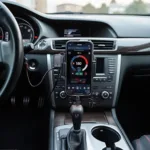OBD2 PIDs are the key to unlocking your car’s inner workings. These standardized codes provide a wealth of information about your vehicle’s performance, emissions, and overall health. This comprehensive guide will delve into the intricacies of OBD2 PIDs, explaining what they are, how they work, and why they are essential for both car owners and professionals.
What are OBD2 PIDs?
OBD2 PIDs, or Parameter IDs, are hexadecimal codes that represent specific data points within a vehicle’s onboard diagnostic system. They act as addresses for various parameters, allowing diagnostic tools to request and receive specific information from the car’s computer. For instance, a PID might correspond to engine coolant temperature, fuel pressure, or even the status of the catalytic converter. Each PID is unique and designed to retrieve a specific piece of data, making them essential for troubleshooting and performance monitoring. can obd2 pids hurt your ecu
How do OBD2 PIDs Work?
When you connect an OBD2 scanner to your car’s diagnostic port, it communicates with the vehicle’s electronic control unit (ECU) using these PIDs. The scanner sends a request for specific PIDs, and the ECU responds by providing the corresponding data. This data is then displayed on the scanner’s screen, providing valuable insights into your vehicle’s operation. Think of it like asking your car specific questions, and the PIDs are the language you use to get the answers you need.
Why are OBD2 PIDs Important?
OBD2 PIDs are vital for diagnosing car problems, optimizing performance, and ensuring your vehicle runs smoothly. Mechanics use them to pinpoint the source of malfunctions, identify potential issues before they become major problems, and track the effectiveness of repairs. For car enthusiasts, PIDs offer a powerful tool for monitoring performance metrics, analyzing fuel economy, and even customizing their car’s behavior. obd2 pid listing
Common Uses of OBD2 PIDs
- Diagnostics: Identifying the root cause of check engine lights and other warning indicators.
- Performance Tuning: Monitoring real-time data to optimize engine performance and fuel efficiency.
- Emissions Testing: Verifying that a vehicle meets emissions standards.
- Preventative Maintenance: Tracking key parameters to identify potential issues before they escalate.
Decoding OBD2 PID Data
While OBD2 scanners present data in a user-friendly format, understanding the raw PID data can provide a deeper level of insight. This data is typically presented in hexadecimal format and requires some interpretation. Fortunately, numerous resources are available online and in service manuals that explain the meaning of each PID and how to decode the data. acura obd2 pid
Where Can I Find a List of OBD2 PIDs?
Comprehensive lists of OBD2 PIDs are readily available online and in service manuals. These lists provide detailed information about each PID, including its hexadecimal code, the data it represents, and the units of measurement.
“Understanding OBD2 PIDs is like learning your car’s secret language,” says automotive expert, Dr. Emily Carter, “It allows you to communicate directly with your vehicle’s computer and gain a deeper understanding of its operation.”
Advanced OBD2 PID Usage
Beyond basic diagnostics and performance monitoring, OBD2 PIDs can be used for more advanced applications. Some enthusiasts even use custom software to create their own dashboards and data logging systems. This allows for detailed analysis of vehicle performance and can be invaluable for troubleshooting complex issues. obd2 pid definitions
“With the right tools and knowledge, OBD2 PIDs can unlock a whole new level of control over your vehicle,” explains automotive engineer, Michael Davis. “From optimizing fuel economy to diagnosing intermittent problems, the possibilities are endless.”
Future of OBD2 PIDs
As cars become increasingly sophisticated, the role of OBD2 PIDs will continue to evolve. With the advent of connected cars and the Internet of Things (IoT), PIDs are likely to play a crucial role in remote diagnostics, predictive maintenance, and even autonomous driving.
Conclusion
OBD2 PIDs are a powerful tool for anyone who wants to understand and interact with their car’s inner workings. From simple diagnostics to advanced performance tuning, these codes provide a wealth of information that can help you keep your vehicle running smoothly for years to come. 96 to 99 mustang torque pro obd2 pids Learning about OBD2 PIDs is an investment in your vehicle’s health and longevity.
FAQ
- What does OBD2 stand for? On-Board Diagnostics, Second Generation.
- Do all cars have OBD2 ports? Most cars manufactured after 1996 in the US and after 2001 in Europe have OBD2 ports.
- Can I use any OBD2 scanner with my car? Most OBD2 scanners are compatible with a wide range of vehicles, but some scanners may have specific features or functionalities for certain makes and models.
- What is the difference between generic and manufacturer-specific PIDs? Generic PIDs are standardized across all vehicles, while manufacturer-specific PIDs provide access to data specific to a particular make or model.
- Are OBD2 PIDs the same as diagnostic trouble codes (DTCs)? No, PIDs are used to request specific data from the vehicle’s computer, while DTCs are codes that indicate specific malfunctions.
- Where can I learn more about OBD2 PIDs? Numerous resources are available online, in service manuals, and from automotive experts.
- What is the future of OBD2 technology? OBD2 technology is constantly evolving and is expected to play a crucial role in the development of connected cars and autonomous driving.
Need assistance? Contact us via WhatsApp: +1(641)206-8880, Email: [email protected] or visit our office at 789 Elm Street, San Francisco, CA 94102, USA. Our customer service team is available 24/7.

